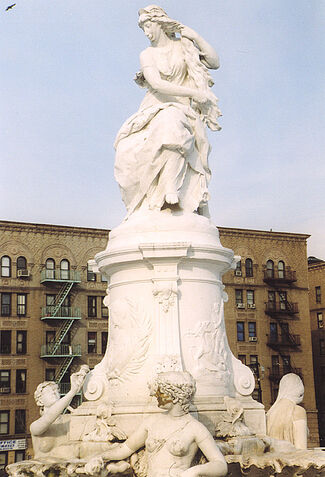Lorelei's Song (Die Lorelei or Das Loreleylied) is a poem by Heinrich Heine, written in 1824.
Lorelei's Song[]

Lorelei monument, by Ernst Herter (1846-1917) in Joyce Kilmer Park, Bronx, NY, in 2003. Photo by Schreibkraft. Licensed under Creative Commons, courtesy Wikimedia Commons.
If there's reason, I can't recall it,
Why I feel sick and tense.
A fable demands I tell it,
An old tale without sense.
The heavens are cool and dark now
And quiet flows the Rhine;
The peak of the Rock is a spark now
Of summer eveningshine.
In glory amid the last light
There sits a maid most fair.
Her garment and jewels shine bright
As she combs her golden hair
With a golden comb; and she's singing
The most marvellous song to me.
Even piercing my drums could not bring
Escape from that melody.
In my skiff I am a captive
Of each melodious note,
Caring nothing for the rapids
That wait to sink my boat.
The waves will be devouring,
Too soon, both skiff and I;
And I will die still hearing
The song of Lorelei.
&mdash translated by George J. Dance, 2009
Background[]
The Lorelei (Template:Lang-de, Template:IPA-de) is a rock on the eastern bank of the Rhine] near St. Goarshausen, Germany, which soars some 120 metres above the waterline. It marks the narrowest part of the river between Switzerland and the North Sea, and is the most famous feature of the Rhine Gorge, a 65 km section of the river between Koblenz and Bingen am Rhein that was added to the UNESCO World Heritage Sites in June 2002. A very strong current and rocks below the waterline have caused many boat accidents there.
Lorelei is also the name of a feminine water spirit, similar to mermaids or Rhinemaidens, associated with this rock in popular folklore and in works of music, art and literature.
The name comes from the old German words lureln, Rhine dialect for "murmuring", and the Celtic term ley "rock". The translation of the name would therefore be: "murmur rock" or "murmuring rock". The heavy currents, and a small waterfall in the area (still visible in the early 19th century) created a murmuring sound, and this combined with the special echo the rock produces to act as a sort of amplifier, giving the rock its name.[1] The murmuring is hard to hear today owing to the urbanization of the area. Other theories attribute the name to the many accidents, by combining the German verb "lauern" (to lurk, lie in wait) with the same "ley" ending, with the translation "lurking rock".
By the German language orthographic reform of 1903, in almost all German terms letter "y" was changed for letter "i", but in some German names the letter "y" was kept, such as Speyer, Spay, (Rheinberg-)Orsoy, and including Loreley, which is thus the correct spelling in German.(Citation needed)
In 1801, German author Clemens Brentano composed his ballad Zu Bacharach am Rheine as part of a fragmentary continuation of his novel Godwi oder Das steinerne Bild der Mutter. It told the story of an enchanting female associated with the rock. In the poem, the beautiful Lore Lay, betrayed by her sweetheart, is accused of bewitching men and causing their death. Rather than sentence her to death, the bishop consigns her to a nunnery. On the way thereto, accompanied by 3 knights, she comes to the Lorelei rock. She asks permission to climb it and view the Rhine once again. She does so and falls to her death; the rock still retained an echo of her name afterwards. Brentano had taken inspiration from Ovid and the Echo myth.
In 1824, Heinrich Heine seized on and adapted Brentano's theme. Heine describes the eponymous female as a sort of siren who, sitting on the cliff above the Rhine and combing her golden hair, unwittingly distracted shipmen with her beauty and song, causing them to crash on the rocks.
Musical settings[]
In 1837 Heine's lyrics were set to music by Friedrich Silcher in the art song Lorelei[2] that became well known in German-speaking lands. A setting by Franz Liszt. was also favored. Over a score of other musicians have set the poem to music.[3]
References[]
- ↑ Loreley - Ein Beitrag zur Namendeutung. Accessed June 16, 2006.
- ↑ Note: A scan of the sheet music and lyrics (printed in 1859; note the spelling "Lorelei") are available on the commons in three images: File:Lorelei1.gif, File:Lorelei2.gif, File:Lorelei3.gif
- ↑ File:Wikisource-logo.svg Chisholm, Hugh, ed (1911). "Lorelei". Encyclopædia Britannica (11th ed.). Cambridge University Press.
External links[]
- Text
- Die Lorelei" in German (with English translation)
- poem and translation (by A.Z. Foreman) at Poems in Translation
| This page uses Creative Commons Licensed content from Wikipedia. (view article). (view authors). |